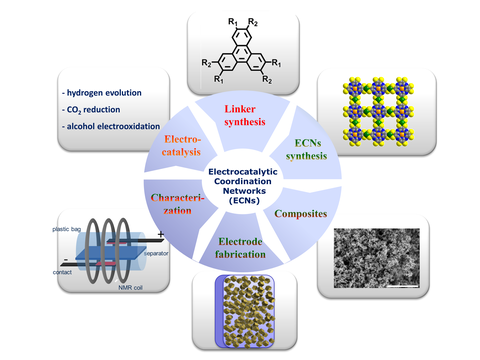Electrocatalytic Coordination Networks
Duration: July 2016 - June 2019
Priority Programme 1928 - Coordination Networks: Building Blocks for Functional Systems
Porous coordination networks (PCNs) are ideal candidates for selective electrocatalytic transformations since they enable highly selective adsorptive enrichment of small molecules inside pores and at the same time the integration of catalytically active sites, originating from transition metals as nodes or dopants generating tunable redox functions as building blocks in electrocatalytic coordination networks (ECNs).
One reason for the limited reports on PCNs as electrocatalysts is the lack of electrical conductivity in established CN systems. Additionally the limited availability of liquid phase adsorption data and the instability of some CNs towards aqueous electrolytes compromise systematic progress in the field. As a technical challenge, processing such materials into thin film electrodes is a key requirement to achieve high performance catalysts.
Electrocatalysis for the generation of valuable intermediates poses a huge potential for the use of low-cost electrical energy emerging from the fluctuating energy supply of renewable resources. Reduction of greenhouse gases such as CO2 and conversion into valuable fuels such as methanol and methane is a promising target. Moreover a high potential of highly selective CNs is anticipated for fine chemical intermediates, for example the selective oxidation of alcohols from fermentation processes.
This project will focus on the generation of ECNs and their integration into electrodes for electrocatalysis where the CN enhances the substrate concentration in vicinity to the active site by selective adsorption. The electron transfer is envisioned to be realized either by the I) coordination network itself, or II) a catalytically active nanomaterial (NM: nanoparticle, graphene surface etc.) using a composite approach. In an interdisciplinary approach the project will cover the whole process chain from the design and synthesis of molecular building blocks, ECN synthesis, development of required processing and characterization techniques towards function demonstration in selected electrocatalytic model reactions including hydrogen evolution reaction (HER), CO2 reduction, and alcohol electrooxidation for the production of fine chemicals.

